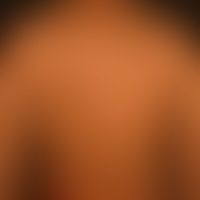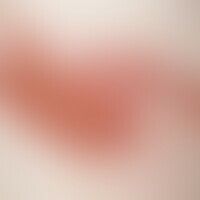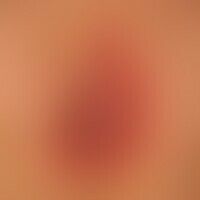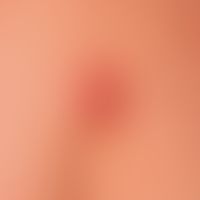Image diagnoses for "Torso"
551 results with 2173 images
Results forTorso

Mallorca acne L70.8
acne, majorca acne. single papules. round papules with ectatic papillary capillaries. in the surroundings numerous equally sized round sweat gland ostia in sun-tanned skin.

Nummular dermatitis L30.0
Nummular dermatitis: Detail enlargement: Sharply defined, 2-6 cm large, inflammatory reddened, coin-shaped plaques on the left shoulder blade in a 7-year-old girl.

Psoriasis (Übersicht) L40.-
Psoriasis: pre-treated psoriatic plaques and papules (relapsing-active psoriasis). The textbook described scaling is missing (caused by pre-treatment). However, this is rather the normal finding nowadays.

Nevus verrucosus Q82.5
Naevus verrucosus with bizarre arrangement of brownish papules and plaques along the Blaschko lines.

Poikilodermia vascularis atrophicans L94.5
Poikilodermia vascularis atrophicans. 63-year-old patient with a slowly progressive, varicolored-checked clinical picture of the skin that has been present for 20 years. The varicolored skin is caused by reticular or stripe-shaped erythema. Especially in the neck and décolleté area, this is accompanied by reticular or flat brown discoloration (hyperpigmentation). The varicolored appearance is further intensified by an apparently normal skin condition that appears in several places (on the chest and neck area as well as on the upper and middle abdomen).

Intermediate leprosy A30.8

Zoster B02.9

Acne conglobata L70.1
Acne conglobata. Inflammatory lumps, large bowl-shaped scars, single keloids around the shoulders.

Mycosis fungoides plaque stage C84.0
Mycosis fungoides (plaque stage): 72-year-old male (so-called plaque stage of Mycosis fungoides); multiple, disseminated, 5.0-10.0 cm large, occasionally slightly itchy, only slightly consistency increased, slightly scaly red, poikilodermatic plaques are found.

Drug effect adverse drug reactions (overview) L27.0

Nevus melanocytic congenital nevus giganteus D22.L5

Early syphilis A51.-
Syphilis early syphilis: papular syphilide. No itching. Generalized lymph node swelling. Syphilis serology positive.

Parapsoriasis en plaques large L41.4
Parapsoriasis en plaques,grandes plaquesForm (Parapsoriasisen grandes plaques): completely symptom-free, yellow-brown (purpura pigmentosa-like), sharply defined spots; only when the skin is wrinkled is a cigarette-paper-like pseudoatrophic architecture of the skin surface discernible (important diagnostic sign!).

Acrocyanosis I73.81; R23.0;
Acrocyanosis; diffuse reddish-livid skin discoloration of both mammae only occurring in cold weather with large-meshed marbling; reduced skin temperature; possible doughy, cushion-like swellings, symmetrical infestation, numbness and iris diaphragm phenomenon.

Dermatomyositis (overview) M33.-
Dermatomyositis: A flat, blurred, in places jagged red and livid erythema following surgery for breast cancer of the right breast.









